PODCAST The tale of the Black Tom Explosion which sent shrapnel into the Statue of Liberty and rocked the region around New York harbor.
On July 30, 1916, at just after 2 in the morning, a massive explosion ripped apart the island of Black Tom on the shoreline near Jersey City, sending a shockwave through the region and thousands of pounds of wartime shrapnel into the neighboring Ellis Island and Bedloe’s Island (home to the Statue of Liberty).
Thousands of windows were shattered in the region, and millions woke up wondering what horrible thing had just happened.
The terrifying disaster was no accident; this was the sabotage of German agents, bent on eliminating tons of munitions that were being sent to the Allied powers during World War I. Although America had not yet entered the war, the United States was considered an enemy combatant thanks to weapons manufactures in the New York region and around the country.
But the surprising epicenter of German spy activity was in a simple townhouse in the neighborhood of Chelsea.
ALSO: New Yorkers still feel the ramifications of the Black Tom Explosion today at one of America’s top tourist attractions.
The Bowery Boys: New York City History podcast is brought to you …. by you!
We are producing a new Bowery Boys podcast every other week. We’re also looking to improve and expand the show in other ways — publishing, social media, live events and other forms of media. But we can only do this with your help!
We are creators on Patreon, a patronage platform where you can support your favorite content creators.
Please visit our page on Patreon and watch a short video of us recording the show and talking about our expansion plans. If you’d like to help out, there are several different pledge levels. Check them out and consider being a sponsor.
We greatly appreciate our listeners and readers and thank you for joining us on this journey so far.
The location of Black Tom Island in relation to Jersey City, circa 1880.
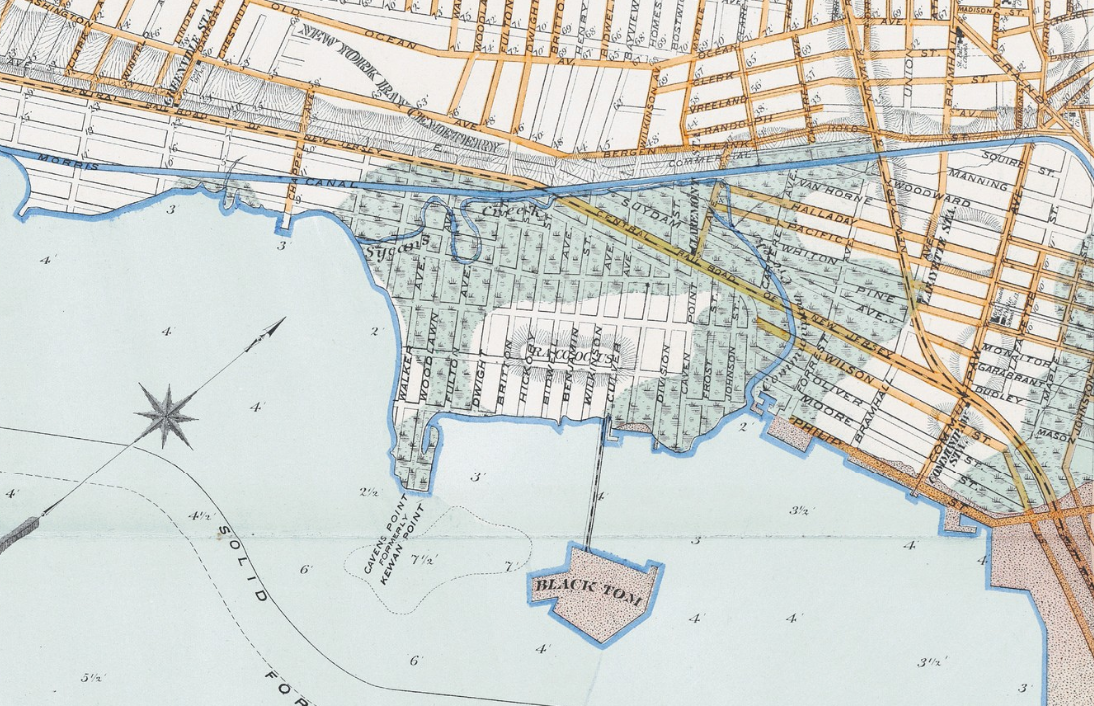
The Statue of Liberty in relation to Black Tom (situated in the background) in 1912
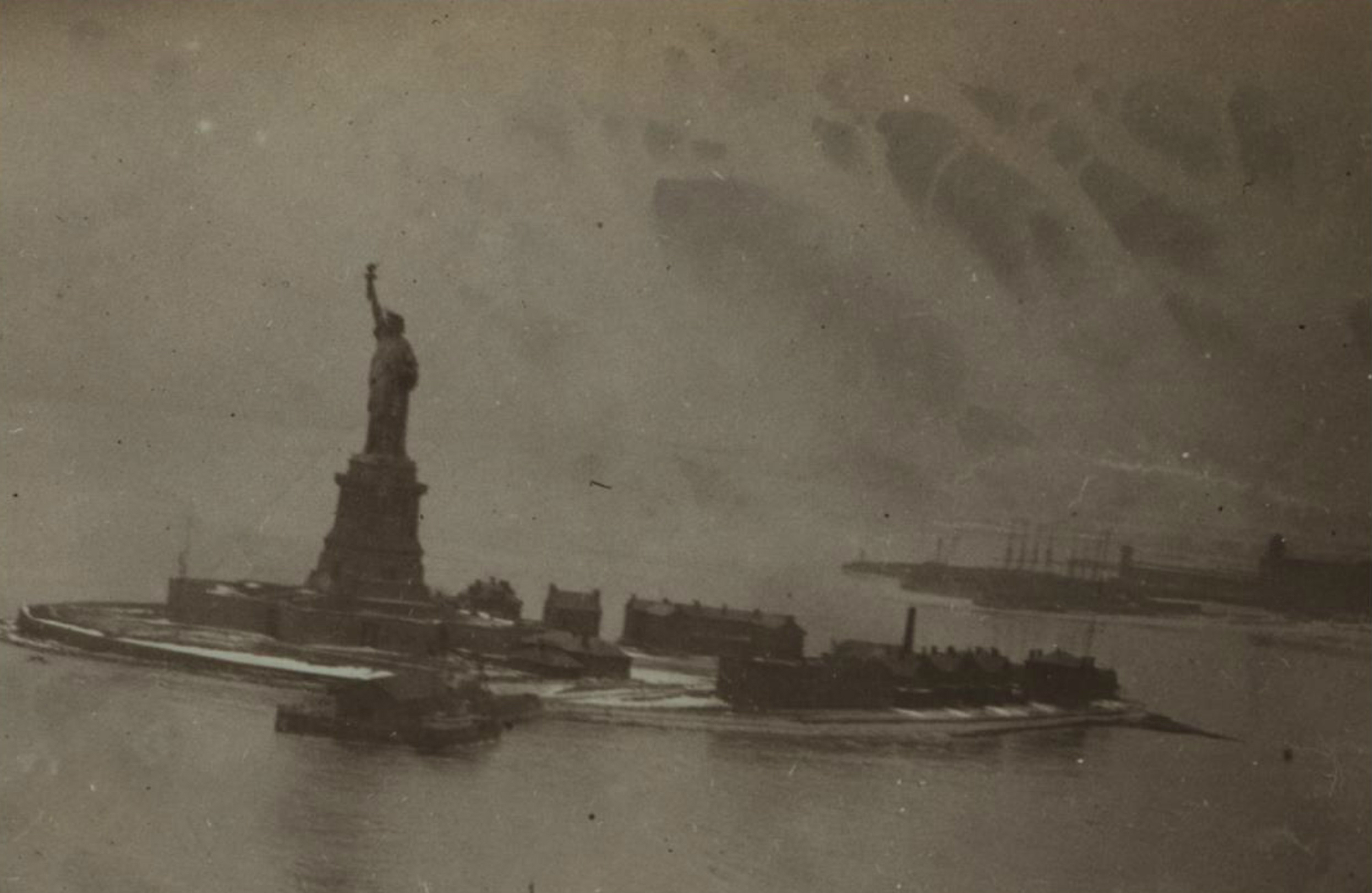
The view of Jersey City from a skyscraper in downtown Manhattan, 1918.
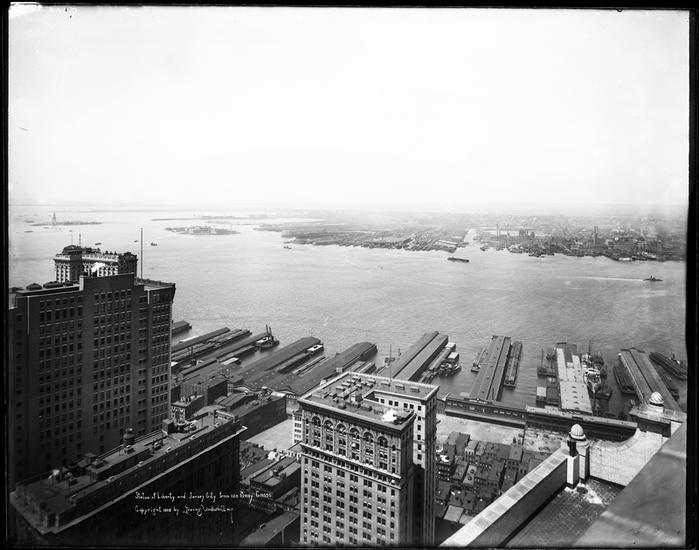
Images of the grim aftermath of the explosion (courtesy Liberty State Park):





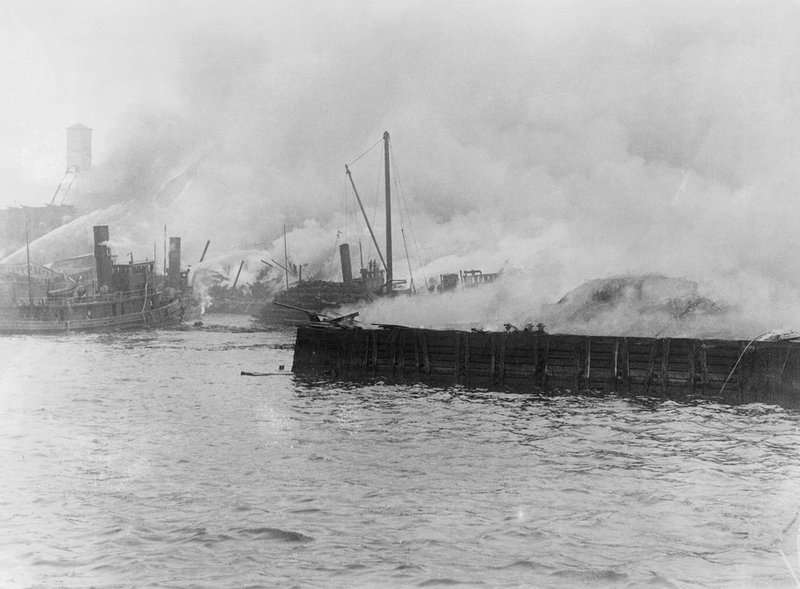
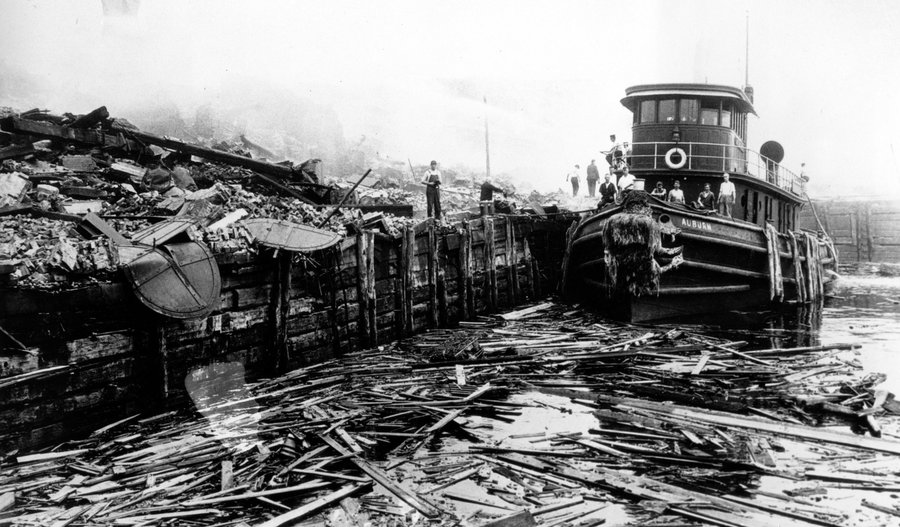
This series of photos (courtesy Library of Congress) shows the efforts of divers and salvagers looking for remaining munitions that had sunk into the harbor!






The front page of the New York Tribune the following day:
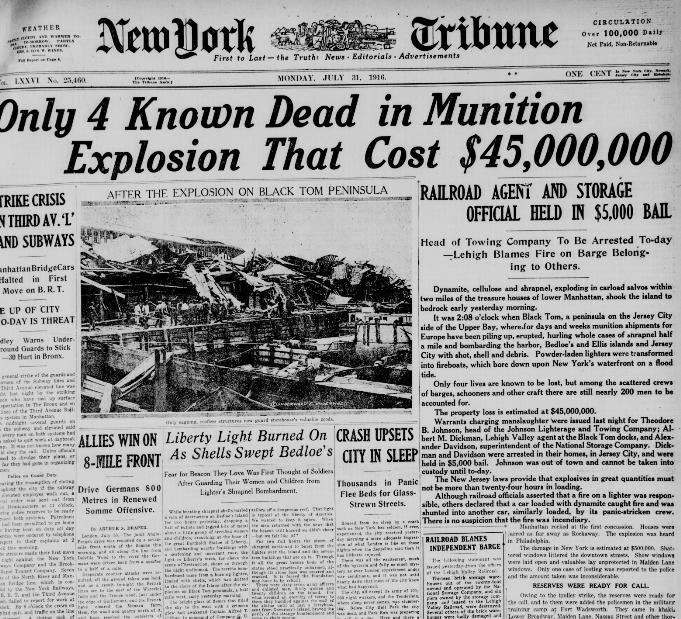
The Kingsland munitions explosion of January 11, 1917, caused millions of dollars in damage, but no lives were lost thanks to the efforts of a single switchboard operator named Tessie McNamara who stayed at her post throughout the disaster.
To give you some idea of the size of the Statue of Liberty’s torch, here’s a picture of its replacement during the 1984 renovation. It can only be accessed via a very narrow stairway.


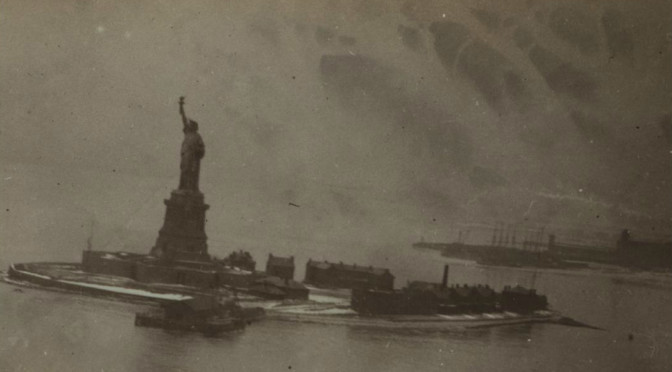
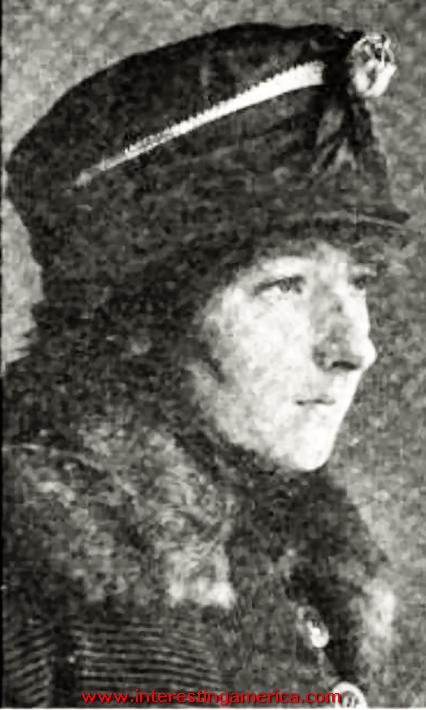
10 replies on “Danger in the Harbor: World War I and the Black Tom Explosion of 1916”
Awesome episode. I had never heard of this event. Best part is that I was listening to it while on the ferry from Hoboken to Wall Street. Really cool to look to my right and see where these events happened.
Thanks for the great podcast and for these pictures. Nothing like the Halifax Explosion, fortunately, but very interesting nonetheless. I have never been to Liberty Park, but now plan to visit.
Great episode as always. I recently re-watched Hitchcock’s “Saboteur.” Although it takes place during WWII, I couldn’t help but draw several parallels between this event and the film (even down to the NY headquarters of the saboteurs, which is at the home of a high society woman). If you haven’t seen it, you should check it out. Or at least watch the climactic Statue of Liberty ending, which I now know apparently would not have been possible…
I will right away grab your rss as I can’t find your email subscription hyperlink or e-newsletter service.
Do you’ve any? Please let me recognise so that I may subscribe.
Thanks.
I could be mistaken, but insofar as access to the torch of the Statue of Liberty goes, the numbers of tourists making the difficult climb to it had grown exponentially from the 1890s onwards as it’s popularity took off. Early custodians were already concerned about increasing congestion inside Liberty and especially the torch. Congestion in the torch had become so bad that Liberty’s custodians were trying to find ways of restricting access without causing an uproar with tourists.
When the Black Tom explosion happened, it caused a great deal of minor damage to Liberty but nothing structurally dangerous. The clever custodians looking after Liberty took the opportunity to exaggerate the seriousness of the damage to Liberty to lend a veneer of authority to closing off access to the torch for tourists.
The damage Liberty actually suffered from the Black Tom explosion, while costly, did not cause any structural deficiency or weakening of the right arm and shoulder. The right shoulder had already been known to be unusually flexible but it wasn’t until nearly a century later, during the restoration of the 1980s, that engineers and historians working together discovered that the right shoulder of Liberty had been modified at the direction of her sculptor, Frederic Auguste Bartholdi, against the design of Gustave Eiffel.
Bartholdi had originally created Liberty to hold her torch aloft but with her arm out at an angle. Eiffel foresaw the long term difficulty of keeping the awkward angle of the arm in good, strong condition and had attempted to influence Bartholdi to compromise his vision by straightening up the right arm so it would transfer it’s load more directly through the right shoulder into the central pylon. It would have also been more securely anchored and less prone to sway and play in the wind.
Photographs of Liberty taken during her test assembly in Paris reveal that Liberty was nearly finished and the support structure of the right arm was already assembled but subsequent photos showed the support of the right arm being disassembled and then rebuilt in a different configuration; it was the original outward angle that Bartholdi had desired for Liberty in defiance of Eiffel’s caution and engineering. It was one of a number of modifications Bartholdi carried out on Liberty after seeing her at full size.
When Liberty arrived here and was finally erected atop her pedestal, it was generally common knowledge with most of the engineers involved that she had a weak right shoulder which gave too much free play to her torch-bearing arm.
Not many in the public were aware of this and coupled with the Black Tom explosion plus the growing problem of tourist congestion in the torch was reason enough to put out a white lie about Liberty being too damaged to permit visitors to the torch anymore.
Much of what I learned about this was gleaned from Barry Moreno’s “Statue of Liberty Encyclopedia” a few years ago. I can’t recall exactly what pages as I don’t have a copy around anymore, but I thought you’d be interested to hear how people were mistakenly told for decades that the damage from the Black Tom explosion was the sole reason nobody aside from staff were permitted to visit the torch anymore.
Hi,
What was the fabulous music used at the opening of this episode? Sounded familiar but I couldn’t place it.
I’m a long time listener to the podcast, in Adelaide, South Australia. I’m also really looking forward to the book!
Best wishes
Ceba
What is the name of the second song played after the break and who wrote it?
I’m also curious about the pieces of music you used on this episode — can you tell us? Is there a list of music you use on your website? Thanks.
We’re glad you liked the music. It’s actually some royalty-free music that we purchase through a service. It’s not even a real song!
Who was “Black Tom”? Former resident of that area……?